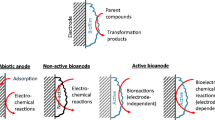Abstract
Herein, we report a new strategy for the simultaneous degradation of lignocellulosic biomass and bioelectricity generation using a novel three-chamber microbial fuel cell (MFC). Oscillatoria annae, a freshwater cyanobacterium, was used for the hydrolysis of cellulose to glucose. The electrocatalytic activity of the coculture of Acetobacter aceti and Gluconobacter roseus was used to oxidize the glucose for current generation in the MFC. Carbon felt was used as the anode and cathode material. Lignocellulosic materials such as sugarcane bagasse and corn cob were used as substrates. The performances of the MFC with two different substrates were analyzed by polarization studies, coulombic efficiency, percentage of COD removal and internal resistance. The three-chamber MFC produced a maximum power output of 8.78 W/m3 at 20.95 A/m3 and 6.73 W/m3 at 17.28 A/m3 with sugarcane bagasse and corn cob as substrates, respectively.
Graphical Abstract





Similar content being viewed by others
References
Baldrian P, Valaskova V (2008) Degradation of cellulose by basidiomycetous fungi. FEMS Microbiol Rev 32:501–521
Bhuvaneswari A, Krishnaraj RN, Berchmans S (2013) Metamorphosis of pathogen to electrigen at the electrode/electrolyte interface: direct electron transfer of Staphylococcus aureus leading to superior electrocatalytic activity. Electrochem Commun 34:25–28
Cayuela ML, Sánchez-Monedero MA, Roig A, Sinicco T, Mondini C (2012) Biochemical changes and GHG emissions during composting of lignocellulosic residues with different N-rich by-products. Chemosphere 88(2):196–203
Chen BY, Liu SQ, Hung JY, Shiau TJ, Wang JM (2013) Reduction of carbon dioxide emission by using microbial fuel cells during wastewater treatment. Aerosol Air Qual Res 13:266–274
Cheng CL, Chang JS (2011) Hydrolysis of lignocellulosic feedstock by novel cellulases originating from Pseudomonas sp. CL3 for fermentative hydrogen production. Bioresour Technol 102:8628–8634
Elmekawy A, Diels L, De Wever H, Pant D (2013) Valorization of cereal based biorefinery by-products: reality and expectations. Environ Sci Technol 47(16):9014–9027
Elmekawy A, Srikanth S, Vanbroekhoven K, De Wever H, Pant D (2014) Bioelectro-catalytic valorization of dark fermentation effluents by acetate oxidizing bacteria in bioelectrochemical system (BES). J Power Sources 262:183–191
Fan Y, Sharbrough E, Liu H (2008) Quantification of the internal resistance distribution of microbial fuel cells. Environ Sci Technol 42:8101–8107
Heijne AT, Hamelers HVM, Wilde V, Rozendal RA, Buisman CJ (2006) A bipolar membrane combined with ferric iron reduction as an efficient cathode system in microbial fuel cells. Environ Sci Technol 40:5200–5205
Hesas RH, Ashri Wan Daud WM, Sahu JN, Arami-Niya A (2003) The effects of a microwave heating method on the production of activated carbon from agricultural waste: a review. J Anal Appl Pyrol 100:1–11
Horvath AL (2005) Solubility of structurally complicated materials: I. Wood 35:77–92
Ieropoulos IA, Greenman J, Melhuish C, Horsfield I (2012) Microbial fuel cells for robotics: energy autonomy through artificial symbiosis. ChemSusChem 5:1020–1026
Karthikeyan R, Sheela B (2012) Simultaneous degradation of bad wine and electricity generation with the aid of the coexisting biocatalysts Acetobacter aceti and Gluconobacter roseus. Bioresour Technol 104:388–393
Karthikeyan R, Sathishkumar K, Murugesan M, Sheela B, Yegnaraman V (2009) Bioelectrocatalysis of Acetobacter aceti and Gluconobacter roseus for current generation. Environ Sci Technol 43:8684–8689
Karthikeyan R, Uskaikar HP, Berchmans S (2012) Electrochemically prepared manganese oxide as a cathode material for a microbial fuel cell. Anal Lett 45:1645–1657
Krishnaraj RN, Berchmans S, Pal P (2014) Symbiosis of photosynthetic microorganisms with non photosynthetic ones for the conversion of cellulosic mass into electrical energy and pigments. Cellulose 21:2349–2355
Kudanga T, Mwenje E (2005) Extracellular cellulase production by tropical isolates of Aureobasidium pullulans. Can J Microbiol 51:773–776
Lee SF, Forsberg CW, Gibbins LW (1985) Cellulolytic activity of Clostridium acetobutylicum. Appl Environ microbiol 50:220–228
Logan BE, Rabaey K (2012) Converssion of wastes into bioelectricity and chemicals by using microbial electrochemical technologies. Science 337:686–690
Maeda K, Morioka R, Osada T (2009) Effect of covering composting piles with mature compost on ammonia emission and microbial community structure of composting process. J Environ Qual 38(2):598–606
Mahar RB, Liu J, Li H, Nie Y (2009) Bio-pretreatment of municipal solid waste prior to landfilling and its kinetics. Biodegradation 20:319–330
Martinez D, Berka RM, Henrissat B, Saloheimo M, Arvas M (2008) Genome sequencing and analysis of the biomass-degrading fungus Trichoderma reesei (syn Hypocrea jecorina). Nat Biotechnol 26:553–560
Miller GL (1959) Use of dinitrosalicylic acid reagent for determination of reducing sugar. Anal Chem 31:426–428
Mosier N, Wyman C, Dale B, Elander R, Lee YY, Holtzapple M, Ladisch M (2005) Features of promising technologies for pretreatment of lignocellulosic biomass. Bioresour Technol 96:673–686
Niu CG, Wang Y, Zhang XG, Zeng GM, Huang DW, Ruan M, Li XW (2012) Decolorization of an azo dye Orange G in microbial fuel cells using Fe(II)-EDTA catalyzed persulfate. Bioresour Technol 126:101–106
Pant D, Arslan D, Van Bogaert G, Gallego YA, De Wever H, Diels L, Vanbroekhoven K (2013) Integrated conversion of food waste diluted with sewage into volatile fatty acids through fermentation and electricity through a fuel cell. Environ Technol 34(13–16):1935–1945
Prabha DS, Karthikeyan K, Krishnaraj RN, Akila BM, Hemanth S, Harikrishnan R, Archunan G, Malliga P (2009) Effect of phenolic compounds released during degradation of Coir pith by Oscillatoria annae on Albino rat (Rattus norvegicus). J Appl Sci Environ Manage 13(4):87–90
Rabaey K, Verstraete W (2005) Microbial fuel cells: novel biotechnology for energy generation. Trends Biotechnol 23:291–298
Saha SK, Swaminathan P, Raghavan C, Uma L, Subramanian G (2010) Ligninolytic and antioxidative enzymes of a marine cyanobacterium Oscillatoria willei BDU 130511 during Poly R-478 decolourization. Bioresour Technol 101(9):3076–3084
Schröder U (2007) Anodic electron transfer mechanisms in microbial fuel cells and their energy efficiency. Phys Chem Chem Phys 9:2619–2629
Singh A, Sharma S (2005) Composting of a crop residue through treatment with microorganisms and subsequent vermicomposting. Bioresour Technol 85:107–111
Singh A, Pant D, Stig IO, Poonam SN (2012) Key issues to consider in microalgae based biodiesel production. Energy Educ Sci Technol Part A Energy Sci Res 29(1):563–576
Trejo-Hernández MR, Ortiz A, Okoh AI, Morales D, Quintero R (2007) Biodegradation of heavy crude oil Maya using spent compost and sugar cane bagasse wastes. Chemosphere 68(5):848–855
Varalakshmi P (2007) Plant growth regulators from cyanobacteria. PhD thesis, submitted to Department of Marine Biotechnology, NFMC, Bharathidasan University, Tiruchirappalli-24, Tamilnadu, India
Viswajith V (2008) Potentials of Oscillatoria annae in producing bioethanol and plant growth regulator by the degradation of selected lignocellulosic, PhD dissertation, Bharathidasan University, Tiruchirappalli-24, Tamilnadu, India
Yang B, Wyman CE (2008) Pretreatment: the key to unlocking low-cost cellulosic ethanol. Biofuels Bioprod Bioref 2:26–40
Yang J, Zhou M, Zhao Y, Zhang C, Hu Y (2013) Electrosorption driven by microbial fuel cells to remove phenol without external power supply. Bioresour Technol 150:271–277
Yeber MC, Rodríguez J, Freer J, Durán N, Mansilla HD (2000) Photocatalytic degradation of cellulose bleaching effluent by supported TiO2 and ZnO. Chemosphere 41(8):1193–1197
You S, Zhao O, Zhang J, Jiang J, Zhao S (2006) A microbial fuel cell using permanganate as the cathodic electron acceptor. J Power Sources 162:1409–1415
Zhang F, Tian L, He Z (2011) Powering a wireless temperature sensor using sediment microbial fuel cells with vertical arrangement of electrodes. J Power Sources 196:9568–9573
Zhu G, Onodera T, Tandukar M, Pavlostathis SG (2013) Simultaneous carbon removal, denitrification and power generation in a membrane-less microbial fuel cell. Bioresour Technol 146:1–6
Author information
Authors and Affiliations
Corresponding author
Electronic supplementary material
Below is the link to the electronic supplementary material.
Rights and permissions
About this article
Cite this article
Krishnaraj, R.N., Berchmans, S. & Pal, P. The three-compartment microbial fuel cell: a new sustainable approach to bioelectricity generation from lignocellulosic biomass. Cellulose 22, 655–662 (2015). https://doi.org/10.1007/s10570-014-0463-4
Received:
Accepted:
Published:
Issue Date:
DOI: https://doi.org/10.1007/s10570-014-0463-4




